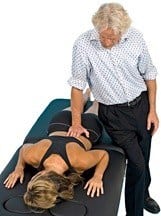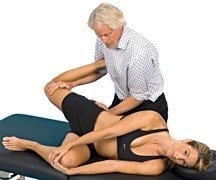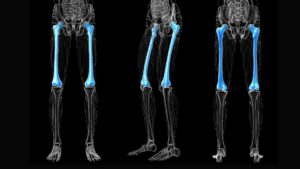
A highly debated postural issue begging for a logical explanation is the SHORT right-leg syndrome” (Fig. 1). Although an inferred awareness of right-sided limb-length shortness
right-leg syndrome” (Fig. 1). Although an inferred awareness of right-sided limb-length shortness has existed for centuries, along with decades of published research, no one has provided a universally acceptable answer to two very IMPORTANT
has existed for centuries, along with decades of published research, no one has provided a universally acceptable answer to two very IMPORTANT questions:
questions:
* Why the unusual frequency of short right legs seen in clinic?
* How does this common postural pattern cause compensatory hip, back and pelvic pain?
Let’s begin by reviewing notable research regarding functional and structural short right legs and then discuss theories, assessments and corrections that help deal with this troublesome disorder. As Sir William Osler once stated, “In order to treat something, we must first be able to recognize it.” Any attempt to tackle limb-length discrepancy and associated compensations, armed with inadequate evaluation TOOLS , surely will lead to failure and frustration. In the absence of radiographic measurements, massage therapists must develop keen palpatory and visual skills for detecting osseous and soft-tissue dysfunction. Aberrant patterns are best identified and classified using the acronym
, surely will lead to failure and frustration. In the absence of radiographic measurements, massage therapists must develop keen palpatory and visual skills for detecting osseous and soft-tissue dysfunction. Aberrant patterns are best identified and classified using the acronym
ART: Asymmetry, Restriction of motion, and Tissue-texture abnormality. Although numerous tests and treatment modalities have proven successful in treating short legs and associated compensations, we’ll focus on only a few fundamental myoskeletal techniques that add to your toolbox of touch.
Leg Length and Back Pain

Fig. 2. SHORT
 right leg causing contralateral pelvic rotation.
right leg causing contralateral pelvic rotation.In two exquisitely designed studies (1962 and 1983), Denslow and Chase measured leg-length discrepancy in 361 and 294 subjects presenting with low back pain.11 Using the most advanced radiographic technology currently available, their papers (published in theAmerican Academy of Osteopathy) reported the following findings concerning limb-length discrepancy:
* Significant incidence of short right legs (66 percent);
* Lumbar convexity to the short leg side (sidebent left – rotated right); and
* A high correlation depicting contralateral (left) pelvic rotation.(Fig. 2)
By comparing sagittal-plane femoral-head height and sacral base angulation (Fig. 3), the authors concluded that innominate bones rotate around the sacrum (iliosacral tilt). Transverse plane images revealed that the pelvis also can rotate as a block around the vertical lumbar spine. Denslow and Chase’s pioneering work helped biomedical researchers understand how shortened limbs torsion the pelvis, creating painful lumbar compensations. Their data not only confirmed leg-length findings conducted by previous researchers but also prompted new, more sophisticated imaging studies. In 2004, John H. Juhl, DO, reported that 68 percent of 421 low back pain patients presented radiographically with short right legs.2
Functional Leg-Length Assessments

Fig. 3. Low right-femoral head and sacral base with compensatory lumbar scoliosis (sidebent left, rotated right).
Through the years, manual therapists have developed many creative ways to differentiate functional (fixable) from structural (true) limb-length differences. Screening exams taught in educational programs often place too much emphasis on supine leg-length assessment in determining pelvic disorders. Commonly, one leg will appear shorter during visual observation of the supine client’s medial malleoli (Fig. 4) when, in fact, the leg lengths actually are equal or just the opposite of how they appear radiographically when standing. For example, in the presence of a true (structural) short right leg, standing ASIS measurements should show an inferior slope on the short side. However, when the client lies supine (removed from vertical gravitational compression), the left leg may suddenly test shorter than the right.
right leg, standing ASIS measurements should show an inferior slope on the short side. However, when the client lies supine (removed from vertical gravitational compression), the left leg may suddenly test shorter than the right.

Fig. 4. Supine leg test; a visual comparison of medial malleoli height.
While many factors may contribute to this finding, one of the most common culprits is length/strength imbalance in deep intrinsic postural muscles such as the quadratus lumborum (QL). When unilaterally short and tight, the QL can ‘hip hike’ the left ilium as the client assumes an off-weighted supine posture. Confusion mounts as the left leg now appears shorter than the right.
Fig. 5 presents an effective contract/relax/assist maneuver to lengthen the hypercontracted left QL.
Although leg, hip and pelvic corrections shouldn’t be based solely on supine test results, helpful information is derived by combining it with other exams such as prone leg-length tests. These oft-neglected prone assessments offer therapists additional clues for solving the limb- length puzzle. When prone, both ASISs are “pinned” to the TABLE , thus preventing ilial rotation and allowing the therapist to isolate sacroiliac and axial skeletal joint dysfunction. Here’s a quick reference for differentiating supine from prone limb-length assessment:
, thus preventing ilial rotation and allowing the therapist to isolate sacroiliac and axial skeletal joint dysfunction. Here’s a quick reference for differentiating supine from prone limb-length assessment:
* Supine: Tests leg-length differences resulting from iliosacral rotation, typically due to muscle imbalance.
* Prone: Tests leg-length inequality as the lumbar spine attempts to adapt to sacral-base unleveling in the presence of SI joint dysfunction.

Fig. 5. Contract/relax/assist technique to lengthen tight/short left QL.
Depending on the degree of leg-length shortness, compensations may travel all the way up through the cervical spine and into the cranium (Ascending Syndrome). Conversely, “key” restrictions sometimes begin in the head or neck and travel down the kinetic CHAIN (Descending Syndrome), causing pelvic obliquity and adaptive leg-shortening (Figs. 6A and B).
During the course of an examination, several simple tests help uncover the biomechanical root of the shortened leg. However, none are adequate to fully assess all possible causes. The Derifield (deer-field) Maneuver3 and others discussed below are useful in “weeding out” spinal and pelvic disorders.
The neurological basis for body balance is found in the brain’s reticular system, where the inhibitory and facilitory systems maintain muscle balance. Cranial or cervical fixations can affect lower-limb musculature via tonic neck reflexes, resulting in the appearance of one leg being SHORT when viewed with the client in the prone position. Typically, comparisons are made by observing the feet, with knees in extended and flexed positions, noting any leg- length disparity (Fig. 7).

Fig. 7. Compare HEELS with knees extended and flexed.
To determine if head/neck restrictions might be altering leg length, the therapist places the thumbs inferior to the medial malleoli. The client is asked to turn their head to one side and then the other. If cervical joint restrictions and/or bony spurs “snag” the dural membrane, head-turning can twist and torsion the sacrum, resulting in leg-length changes. Sometimes, the apparent leg-length discrepancy is resolved or even reversed during these cervical rotation maneuvers.
Note: If leftside head rotation causes the legs to become equal, the therapist should label this as a positive left cervical syndrome and proceed to evaluate and correct all motion-restricted cervical segments (including the O-A joint) that could be dragging the dura and shortening the leg.
The second phase of testing begins with the client’s head in neutral with the therapist’s thumbs evaluating medial malleoli height. Once a visual measurement has been noted, the therapist’s hands slightly plantar-flex the client’s feet while slowly bending the knees to 90°, examining for any changes in HEEL height.

Depending on the degree of leg-length SHORTNESS, compensations may travel all the way up through the cervical spine and into the cranium (Ascending Syndrome). Conversely, “key” restrictions sometimes begin in the head or neck and travel down the kinetic chain (Descending Syndrome), causing pelvic obliquity and adaptive leg-shortening (Figs. 6A and B).
During the course of an examination, several simple tests help uncover the biomechanical root of the shortened leg. However, none are adequate to fully assess all possible causes. The Derifield (deer-field) Maneuver3 and others discussed below are useful in “weeding out” spinal and pelvic disorders.
The neurological basis for body balance is found in the brain’s reticular system, where the inhibitory and facilitory systems maintain muscle balance. Cranial or cervical fixations can affect lower-limb musculature via tonic neck reflexes, resulting in the appearance of one leg being SHORT when viewed with the client in the prone position. Typically, comparisons are made by observing the feet, with knees in extended and flexed positions, noting any leg- length disparity (Fig. 7).
To determine if head/neck restrictions might be altering leg length, the therapist places the thumbs inferior to the medial malleoli. The client is asked to turn their head to one side and then the other. If cervical joint restrictions and/or bony spurs “snag” the dural membrane, head-turning can twist and torsion the sacrum, resulting in leg-length changes. Sometimes, the apparent leg-length discrepancy is resolved or even reversed during these cervical rotation maneuvers.
Note: If leftside head rotation causes the legs to become equal, the therapist should label this as a positive left cervical syndrome and proceed to evaluate and correct all motion-restricted cervical segments (including the O-A joint) that could be dragging the dura and shortening the leg.
The second phase of testing begins with the client’s head in neutral with the therapist’s thumbs evaluating medial malleoli height. Once a visual measurement has been noted, the therapist’s hands slightly plantar-flex the client’s feet while slowly bending the knees to 90°, examining for any changes in heel height.
The Derifield Maneuver

Fig. 8. Prone test; leg stays short in knee flexion and extension due to tibia and femur asymmetry.
Four possible findings may be noted during this test:
* Short leg stays short. If one leg is anatomically short, no change in leg length should occur as the knee moves from extension into flexion (Fig. 8). Referral for foot orthotics may be necessary.
* Short leg gets shorter. Sacroiliac and lumbar spine dysfunction can create muscle hypertonicity that shortens the leg in appearance as it is flexed. Figures 9A and B show effective myoskeletal springing maneuvers for derotating the pelvis to correct sacroiliac and lumbar spine asymmetry.

Fig. 9A. Contract/relax/assist technique to de-rotate the pelvic bowl
* Short leg becomes longer. A posteriorly rotated and fixated ilium (usually left) shortens the leg. When accompanied by an adhesive right-anterior hip capsule, increased rectus femoris pull during knee flexion shortens the right extremity causing the left leg to appear as long, or longer, than the right. This is termed cross-over. * The therapist should perform spring tests for a posteriorly fixated left ilium and anteriorly fixated, right hip capsule (Figs. 10A and B).
* Heel Drop: With knees flexed 90°, the therapist allows both heels to drop toward the buttocks to see if one leg falls farther than the other. The HEEL falling farther usually is a positive indicator of a posterior sacral rotation on that side. This finding is noted as a positive Webster’s sign.4 A variety of spring tests can be used to identify and correct the torsion.
Neurological Explanations for Short Legs

Fig. 9B. Correction for a unilateral left-extended sacrum.
When a short-right-legged client stands with each foot resting side by side on bathroom scales, a measurable weight-shift typically occurs to the low side. The Leaning Tower of Pisa demonstrates this normal law of physics. However, the Tower does not possess a nervous system. Several researchers including Kappler, Previc and Pope5,6,7 believe that some individuals unconsciously resist this gravitational pull by sideshifting body weight to the left side, through a prenatal organizational system called cerebral lateralization. Their research theorizes that motor dominance overrides anatomical and gravitational factors in these individuals. It’s thought that right motor dominance has roots in fetal positioning during the third trimester, resulting in the brain’s lateralization process.8

Fig. 10A. Spring test for a posteriorly fixated left ilium.
In the brain, motor dominance typically crosses cortexes from left to right (left brain controls right side of the body). Conveniently, left vestibular dominance, which assists in balance, coordination and orientation, travels ipsilaterally down the left leg to allow left-sided weight bearing during right motor-dominant activities. For instance, a right motor-dominant person typically balances on their left leg to perform tasks such as kicking a ball (Fig. 11). Combining right motor and left vestibular dominance often results in a left-side-shifting maneuver of the pelvis over the vestibularly long left leg during standing (Fig. 12). This neurological postural shift helps explain many unusual pain patterns seen in clinic.
Short Leg Symptoms

Fig. 10B. Right anterior hip-capsule release.
Those with short right legs who bear more to the short right side usually report greater SI joint pain in the right hip and low back area. Examination of the sacrum often reveals a deep right sacral base, positive spring test for anteriorly fixated ilium and tender iliolumbar and sacroiliac ligaments. Conversely, motor-dominant clients who side-shift over the left leg usually experience greater left-sided SI joint pain and a positive spring test for a posteriorly fixated ilium. Symptoms worsen during prolonged walking or running, as overstretched abductors grind against the greater trochanter, creating bursitis, gluteus medius tendinosis and piriformis syndrome.

Fig. 11. Right motor and left vestibular dominance.
Since the human body rarely is symmetrical side to side, testing for loss of joint play often provides more reliable information than analyzing anatomical landmark findings. For decades, therapists have utilized spring tests to determine the presence (or absence) of joint-play in ankles, feet, hips and shoulders. Regrettably, spring tests are not as commonly used to evaluate spinal and sacroiliac joints. Therapists can benefit greatly by observing for common postural patterns during gait, checking anatomical landmarks, and spring-testing questionable structures to see if the findings have relative value.
Iliosacral, SI joint, and lumbar spine spring tests are valuable assessment and treatment TOOLS that fit perfectly into a massage therapy format. Following the supine and prone leg-length tests, specific springing maneuvers can be used to verify findings and correct motion-restricted joints.

Fig. 12. Cerebral lateralization causes side-shifting over the vestibularly dominant left leg.
Since SHORT limbs arise from biomechanical as well as neurological factors, therapists must take time to fully evaluate the client looking for common compensatory patterns such as the short right leg. Visual observation of the client’s gait alerts the therapist to the possibility of cerebral lateralization and accompanying pelvic side-shifting. Supine and prone exams should be compared with other anatomical landmark findings to determine whether iliosacral, sacroiliac or head and neck restrictions are responsible for limb-length problems. Discrepancies greater than 2 cm can be associated with scoliosis, pelvic obliquity and alterations in the normal walking cycle. From a functional standpoint, there is strong, though not conclusive, evidence of an associated increase in the incidence of low back pain and hip joint osteoarthritis.
On sale this week only!
Save 25% off the Essential MAT Assessments course!
NEW! Now available in the enhanced video USB format!
In the “Essential MAT Assessments” course, you’ll learn how to perform 130 essential orthopedic and osteopathic tests, as well as anatomic landmark exams to get to the bottom of your client’s pain complaint. Save 25% this week only! Offer expires Monday, January 12th. Click the button below for more information and to purchase the course. Upon completion, you will receive 16CE hours and a certificate of completion to display in your office. BONUS: Purchase the home study program and receive instant access to our comprehensive eCourse at no extra cost. Begin your journey to mastery today!








